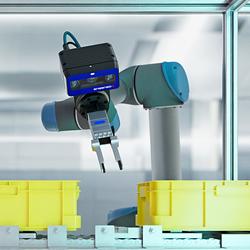Heriot-Watt University Hosts 2014 International Symposium on Robot and Human Interactive Communication
A major international symposium at Heriot-Watt University this week will be considering the future development of robots as they provide care for the elderly and infirm, conduct emergency rescue and security work in inhospitable environments, learn to work increasingly independently and react to human body language to become more effective human companions.
The IEEE RO-MAN 2014
The 2014 International Symposium on Robot and Human Interactive Communication (IEEE RO-MAN 2014), organised by and held at Heriot-Watt, will feature almost 200 presentations from around the world on topical challenges in the field, as well as four keynote speakers. Dr Patricia A. Vargas, a Heriot-Watt academic from the Computer Science Department and General Chair of the symposium, said, "We are honoured to host here at Heriot-Watt University the IEEE RO-MAN 2014. It is the first time RO-MAN has come to Scotland, and it is a unique opportunity for students and researchers to be in touch with some of the best roboticists and state-of-the-art technologies applied to human-robot interaction."
The four internationally recognised invited speakers, Professor Elisabeth André, Professor of Computer Science at Augsburg University, Professor David Lane, Professor of Autonomous Systems Engineering at Heriot-Watt University, Professor William Harwin, Professor of human and interactive systems at the University of Reading and Professor Raja Chatila, senior scientist at the French CNRS, will be discussing areas such as robots providing assisted living for elderly people, autonomous robots in rescue, monitoring and security work, robots which have a real concept of the tasks they are required to do and robots which can more fully understand and interact with humans.
The Symposium also features exhibitions form two FP7 European projects called SCRIPT - Supervised Care and Rehabilitation Involving Personal Tele-robotics, and CogWatch - Cognitive Rehabilitation of Apraxia or Action Disorganisation Syndrome.
http://www.hw.ac.uk/
Featured Product

3D Vision: Ensenso B now also available as a mono version!
This compact 3D camera series combines a very short working distance, a large field of view and a high depth of field - perfect for bin picking applications. With its ability to capture multiple objects over a large area, it can help robots empty containers more efficiently. Now available from IDS Imaging Development Systems. In the color version of the Ensenso B, the stereo system is equipped with two RGB image sensors. This saves additional sensors and reduces installation space and hardware costs. Now, you can also choose your model to be equipped with two 5 MP mono sensors, achieving impressively high spatial precision. With enhanced sharpness and accuracy, you can tackle applications where absolute precision is essential. The great strength of the Ensenso B lies in the very precise detection of objects at close range. It offers a wide field of view and an impressively high depth of field. This means that the area in which an object is in focus is unusually large. At a distance of 30 centimetres between the camera and the object, the Z-accuracy is approx. 0.1 millimetres. The maximum working distance is 2 meters. This 3D camera series complies with protection class IP65/67 and is ideal for use in industrial environments.
